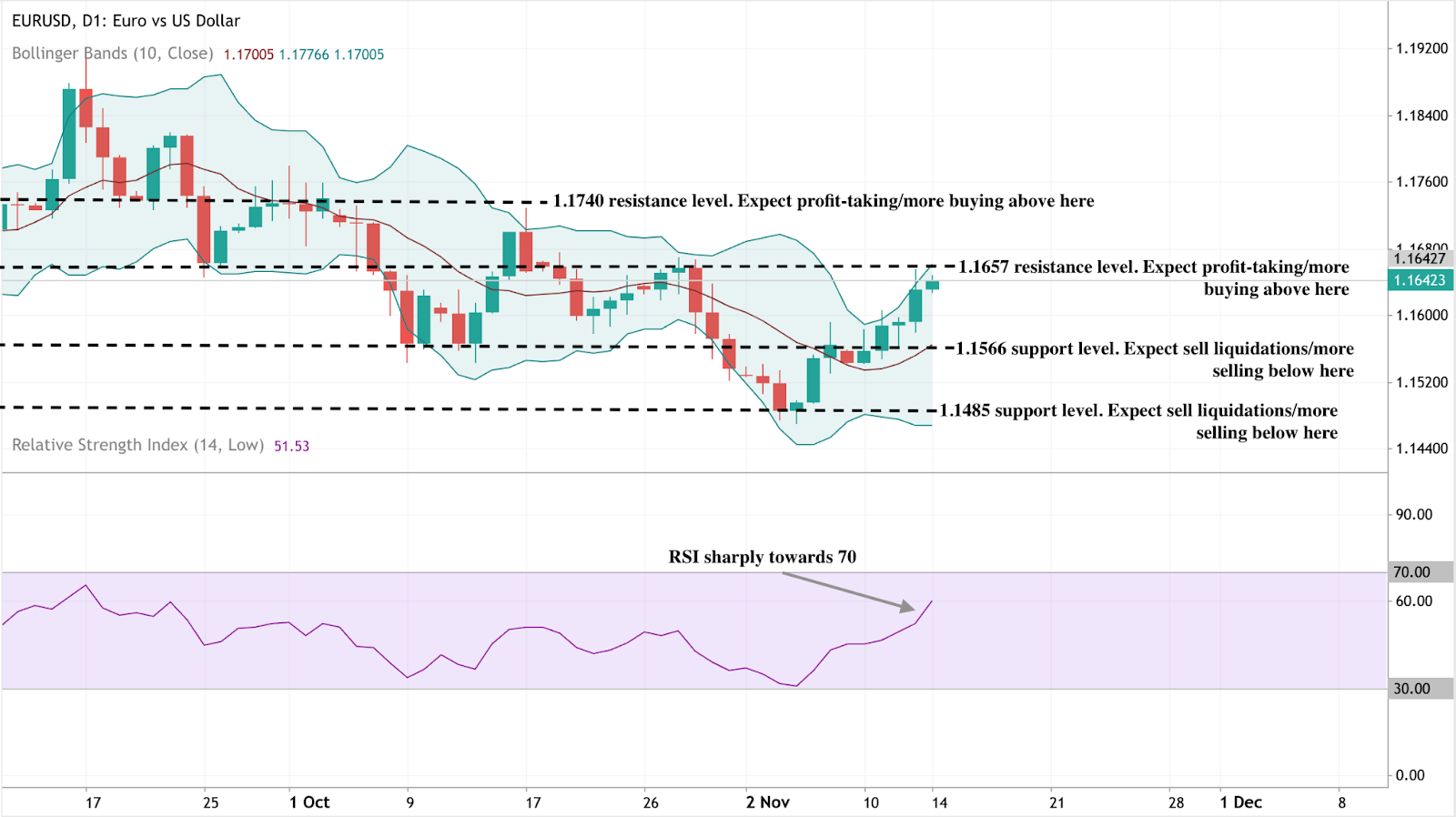EUR/USD outlook ahead of U.S. inflation data and labour data

EUR/USD remains range-bound as markets await clarity from delayed U.S. inflation data. The pair has been trading between 1.156 and 1.166, with traders hesitant to commit until the Consumer Price Index (CPI) figures reveal whether the Federal Reserve will maintain its dovish stance or pause further easing.
The absence of data has reduced volatility and left the euro steady against a softening dollar, as markets weigh growth slowdowns, shifting rate expectations, and improving global risk sentiment.
Key takeaways
- EUR/USD holds steady near 1.1642, trading within a narrow 1.156–1.166 band as traders await CPI data.
- U.S. data delays following the government shutdown have frozen market direction and undermined dollar momentum.
- Policy divergence is narrowing, with the Fed edging towards cuts while the ECB holds steady.
- Eurozone stability and improving sentiment contrast with U.S. uncertainty, supporting the euro’s resilience.
- Volatility compression points to a potential breakout once inflation data is released.
Market stall as US inflation and labour data delays persist
The delayed release of U.S. inflation and labour data has left the market directionless. The Bureau of Labor Statistics (BLS) is still addressing disruptions caused by the recent government shutdown, raising the possibility that some October figures may never be released.
This lack of visibility has paralysed both traders and policymakers. Without CPI or Non-Farm Payrolls data, the Fed’s decision-making is reduced to conjecture. According to the CME FedWatch Tool, markets now price a 52.4% chance of a 25-basis-point rate cut in December, but conviction is fading fast.

Risk appetite, meanwhile, is improving, while European indices are stable - a combination that typically weakens the dollar. As risk-on sentiment spreads, the euro gains passive support from improved capital flows and reduced demand for safe-haven assets.
Euro gains as ECB-Fed policy gap and growth divergence narrow
Beyond the current data blackout, broader fundamentals are tilting in favor of euro support. The IMF forecasts U.S. GDP growth to slow from 2.8% to 2.0% in 2025, while the Eurozone’s growth rate is expected to rise from 0.9% to 1.2%. That narrowing growth gap erodes one of the dollar’s traditional strengths.
Monetary policy is also converging. The European Central Bank (ECB) has likely concluded its easing phase, while the Federal Reserve appears closer to cutting rates as U.S. momentum cools. The narrowing yield differential is historically positive for EUR/USD.
At the same time, Eurozone stability is becoming an asset. Energy risks have receded, political volatility has eased, and consumer confidence is showing faint signs of recovery. With fewer structural risks and steady monetary policy, the euro no longer needs to rally on optimism - it simply needs to stay consistent as the dollar struggles for direction.
CPI data impact: The market’s biggest blind spot
Inflation remains the pivot point. If U.S. CPI surprises to the upside, markets could reprice expectations for a Fed pause, pushing EUR/USD lower. A weaker print, however, would validate the dovish outlook and strengthen the euro’s hand.
For now, the absence of inflation data has become its own catalyst. Without new numbers, traders are increasingly relying on sentiment and technical signals rather than fundamentals. This has compressed volatility and reduced conviction, but the longer it lasts, the stronger the eventual breakout could be.
EUR/USD investment implications: Momentum meets resistance
At the time of writing, EUR/USD is trading near 1.1642, with momentum leaning bullish but facing a critical resistance zone.
The Bollinger Bands indicate that price action is pressing against the upper band, suggesting heightened volatility and strong buying pressure. However, as the pair approaches 1.1657, traders may anticipate profit-taking or short-term consolidation before any further move higher.
A decisive breakout above 1.1740 could reinforce bullish sentiment and attract additional buying interest. On the downside, immediate support lies at 1.1566, with a deeper floor around 1.1485. A break below these levels would likely trigger sell liquidations and renewed downside pressure.
Meanwhile, the RSI is approaching 70, signalling that the pair is nearing overbought territory. This suggests a possible short-term correction before the trend resumes its upward trajectory.

EUR/USD investment implications
For traders, this is a market defined by patience rather than aggression. Range-trading around 1.156–1.166 remains viable, but tight stops are essential given the risk of a data-driven breakout.
Medium-term investors should note that the euro’s underlying stability, narrowing growth gaps, and reduced Eurozone risk could sustain gradual upside momentum towards 1.18–1.20 if the dollar continues to weaken through early 2026.
As volatility compresses, risk management becomes crucial. Using the Deriv trading calculator, traders can estimate pip values, margin requirements, and potential profit or loss before executing a position. This precision helps manage exposure around critical levels, such as 1.156 support or 1.174 resistance - an important edge in low-volatility markets.
With EUR/USD hovering near key technical levels, traders can track live price movements on Deriv MT5 and plan data-driven entries using the Deriv Trading Calculator. When the CPI report is released, both tools will be vital for identifying breakout momentum and managing exposure in real-time.
The performance figures quoted are not a guarantee of future performance.



